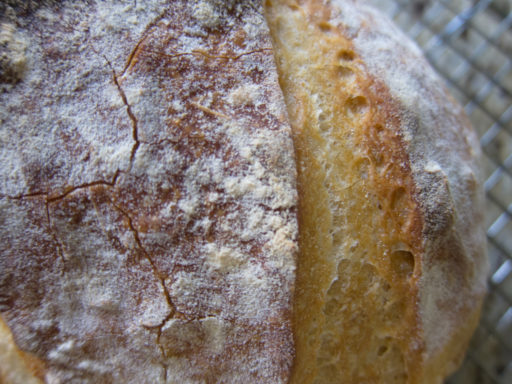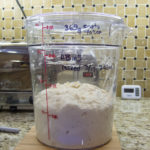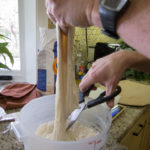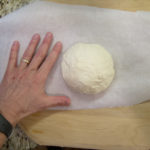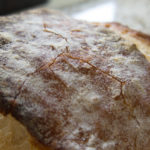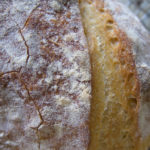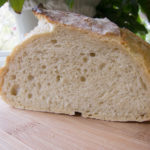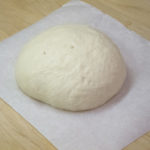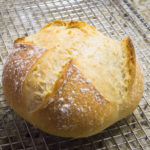Loaf 33 – Artisan Bread in 5 Min. a Day
This recipe is from the book Artisan Bread in Five Minutes a Day by Jeff Hertzberg and Zoe Francois – or ABin5 as its online shorthand has evolved to. The book has been on our shelf for almost a year, and I’m only now delving into it. You can’t actually make bread in five minutes a day, the conceit is that that’s how much of your focused time it will take – you still have to wait a lot, even on a day you want to bake on.
I’m happy that I put off using this book until now. My experience with other breads and lessons from the classes have given me a good foundation to understand what is going on with the ABin5 approach, and to adjust things before even doing my first batch. The basic principle is that you mix up a large batch of wet dough, do a ferment, and then keep it in the refrigerator for up to two weeks so you can take out chuncks to bake when you want fresh bread – and it works!
The book’s recipes all use cups of flour rather than a weight measurement. This scared me given what I’ve learned about the variances in this method, so I went to their website (artisanbreadinfive.com) and found an FAQ reference to what they consider the weight of one cup of flour (140g). Using this I was able to calculate that their basic recipe is a 75% hydration recipe. I was also concerned about the amount of salt, they didn’t specify coarseness and it seemed low to me. Likewise, they had an FAQ posting about that. I decided to just use what I know and adjust the salt to 2% of the weight of the flour (pretty standard). The major difference between their basic ingredients and that in Reinhart’s book is that the ABin5 recipe uses about twice as much yeast (1.5%) – that part I left alone.
On Saturday evening (woohoo!) I mixed up a 1200g batch in a 4 liter container (that was only about five minutes, not including cleanup) and let it sit out. They want you to leave it out until it stops rising, which will be from 2 to 5 hours depending on temperature and other factors. After one hour it had almost tripled in size and had breached the top of the container, so I moved it into a 6L bin. It lost about a third of it’s volume in that process, but by one hour later had peaked at almost 5 liters. And into the fridge it went. That process took a little over two hours; I was checking on it every half hour to track its progress, so I spent extra time on it, but next time I’ll be able to mostly ignore it.
By Sunday afternoon it had shrunk down to about the 4L mark, but was a beautiful evenly bubbled texture. I pulled out a slug and snipped it off for my first loaf from the batch of dough. The chunk weighed in at 366g, which is about right for a nice little dinner loaf for two to four people. The picture below shows me stretching it way out as I cut off the piece, something that I will be more careful about next time. I think the stretching destroyed a lot of the bubbles, making for a denser crumb. I made a small boule out of it and let it sit for 40 minutes while the oven pre-heated. A grid of scores was made (some too deep) and into the oven it went. I also added a cup of water to the pan in the oven to steam a good crust.
As a side note, the dough already has a strong sour odor – something that I haven’t noticed as distinctly in the Reinhart (non-sourdough) recipes.
It needed the full 30 minutes to bake that the recipe called for. I thought it might have been less because of the small size, but that wasn’t the case. I also left it in the oven with the oven turned off and the door opened for another five minutes after it was done.
The end result was a golden delight. Two of my scores were too deep, causing the central square to split away from the loaf, but even that looked, well, artisan.
The crumb was even but dense. It has a very nice flavor, perhaps even sweet, and certainly missing any hint of the sour that we could smell in the raw dough. The crust stayed crispy afterwards, though we did heat it a few hours later again for dinner.
As a first attempt with this recipe and the ABin5 process, I’m quite happy.
Lessons
- The crumb may have been more open if I didn’t have to transfer it from the 4L container to the 6L container, and if I was gentler when taking out the first piece. I’ll be able to test the latter next loaf, and the former next time I try the recipe.
- The book says the flavor will get more sour the longer you wait – I’m interested to see if this happens and how big the difference is.
- Still have to tame my scoring skills.
- About 1600g mixed in container
- About an hour later – oops
- Transferred into bigger container
- The next day – pulling off a chunk to bake
- 366g, about baseball sized
- 40 minutes of rest, some flour and scoring – ready to bake
- Scored a bit too deep, otherwise lovely!
- Cracklin’ crust
- Crust close-up
- Crust close-up
- Crumb – a bit too dense for what I like
- A second loaf the next day
- Second loaf looks nice, too
- Similar crumb to first loaf









